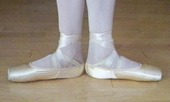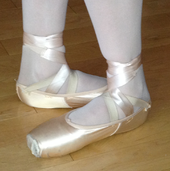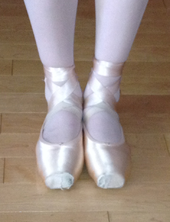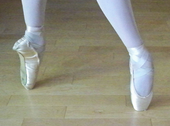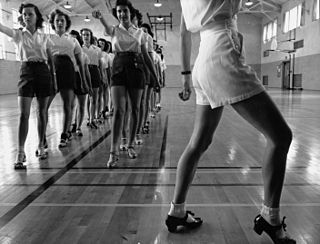
Tap dance is a form of dance that uses the sounds of tap shoes striking the floor as a form of percussion; it is often accompanied by music. Tap dancing can also be a cappella, with no musical accompaniment; the sound of the taps is its own music.
This is a list of dance terms that are not names of dances or types of dances. See List of dances and List of dance style categories for those.
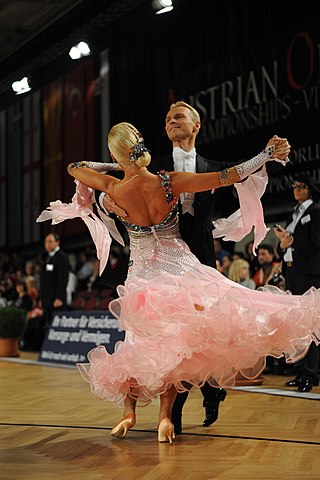
In ballroom dancing, directions of progressive movement, in particular directions of steps, can be indicated either in relation to the room or in relation to the body position. Directions of turns, although there are only two of them, may also be indicated in several ways.
Because ballet became formalized in France, a significant part of ballet terminology is in the French language.
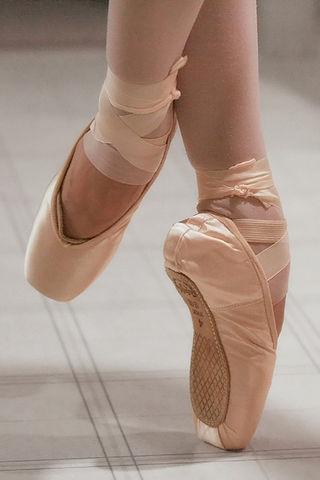
A pointe shoe, also called a ballet shoe, is a type of shoe worn by ballet dancers when performing pointe work. Pointe shoes were conceived in response to the desire for dancers to appear weightless and sylph-like and have evolved to enable dancers to dance en pointe for extended periods of time. They are manufactured in a variety of colors, most commonly in shades of light pink.

Pointe technique is part of classical ballet involving a technique that concerns pointe work, in which a ballet dancer supports all body weight on the tips of fully extended feet when wearing pointe shoes. A dancer is said to be en pointe when the body is supported in this manner, and a fully extended vertical foot is said to be en pointe when touching the floor, even when not bearing weight.
The Bournonville method is a ballet technique and training system devised by the Danish ballet master August Bournonville.
Dance position is the position of a dancer or the mutual position of a dance couple assumed during a dance. Describing and mastering proper dance positions is an important part of dance technique.

Serge Lifar was a Ukrainian dancer and choreographer, and one of the greatest male ballet dancers of the 20th century. Lifar was also a choreographer, director, writer, theoretician about dance, and collector.
Glide step is a form of movement used by marching bands to minimize upper body movement, enabling musicians to play their instruments and march without air-stream interruptions. Standardizing the style of marching also serves to add to the visual effect of a marching band. Sometimes special shoes are worn with a curved heel that facilitates rolling the foot. Glide stepping is used by many high school marching bands, college marching bands, and by many Drum Corps. Glide stepping is sometimes also known as "roll stepping".
The ballet boot is a contemporary style of fetish footwear that merges the look of the pointe shoe with a high heel. The idea is to restrict the wearer's feet almost en pointe, like those of a ballerina, with the aid of long, slender heels. When upright, the feet are held nearly vertical by the shoe, thus putting nearly all of the body's weight on the tips of the toes. However, a properly tight fit will hold the shoe to the wearer's instep and heel, thereby reducing the weight on the wearer's toes.
Karate has many different stances, each used for different types of power and movement. In Japanese the general term is tachi (立ち) changing to dachi when used as a suffix. Some stances focus more on mobility than stability, and vice versa.
On the Dnieper, Op. 51, is a ballet in two scenes with prelude and epilogue by Sergei Prokofiev. Composed in 1931 as his fourth work in the genre, it resulted from a commission by the Ballet de l'Opéra National de Paris after the unexpected death in 1929 of Ballets Russes founder Sergei Diaghilev and after the success of The Prodigal Son. The premiere took place in 1932; a year later Prokofiev extracted an orchestral suite from the work, Op. 51 bis, using six of its twelve movements.
In dance, a pivot turn is a general classification for dance turns in which the performer's body rotates about its vertical axis without traveling. The performer may be supported by one or both feet, which swivel in place during the pivot turn. In some dance genres, a pivot on both feet is called a twist turn. Pivot turns are commonly named as such in ballroom dancing, folk dancing and ethnic dances. In many other dance genres, pivot turns are known by specific names and typically are not referred to as pivots. For example, in ballet, a pirouette is a type of pivot turn on one foot.

Arabesque in dance, particularly ballet, is a body position in which a dancer stands on one leg–the supporting leg–with the other leg–the working leg–turned out and extended behind the body, with both legs held straight.
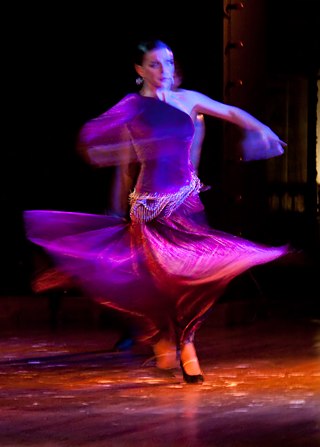
In dance and gymnastics, a turn is a rotation of the body about the vertical axis. It is usually a complete rotation of the body, although quarter (90°) and half (180°) turns are possible for some types of turns. Multiple, consecutive turns are typically named according to the number of 360° rotations.

In ballet, battement is an alternating side-to-side movement of the working leg. Battements are typically performed in multiples, quickly and in rapid succession so that the working foot appears to be fluttering or vibrating. They are usually executed in front, to the side or in back The word battement is of French origin, meaning "beat".
Cyril Atanassoff is a French dancer of Bulgarian descent.

The toe box is the section of footwear that surrounds the toes on closed-toe shoes. Toe boxes that are too tight can cause injuries and foot deformities, whereas wider toe boxes may be used to treat or prevent common foot conditions such as Morton's neuroma. Toe boxes come in a variety of shapes and styles of construction, some of which are a matter of fashion, and some of which are designed for specialized functions.
